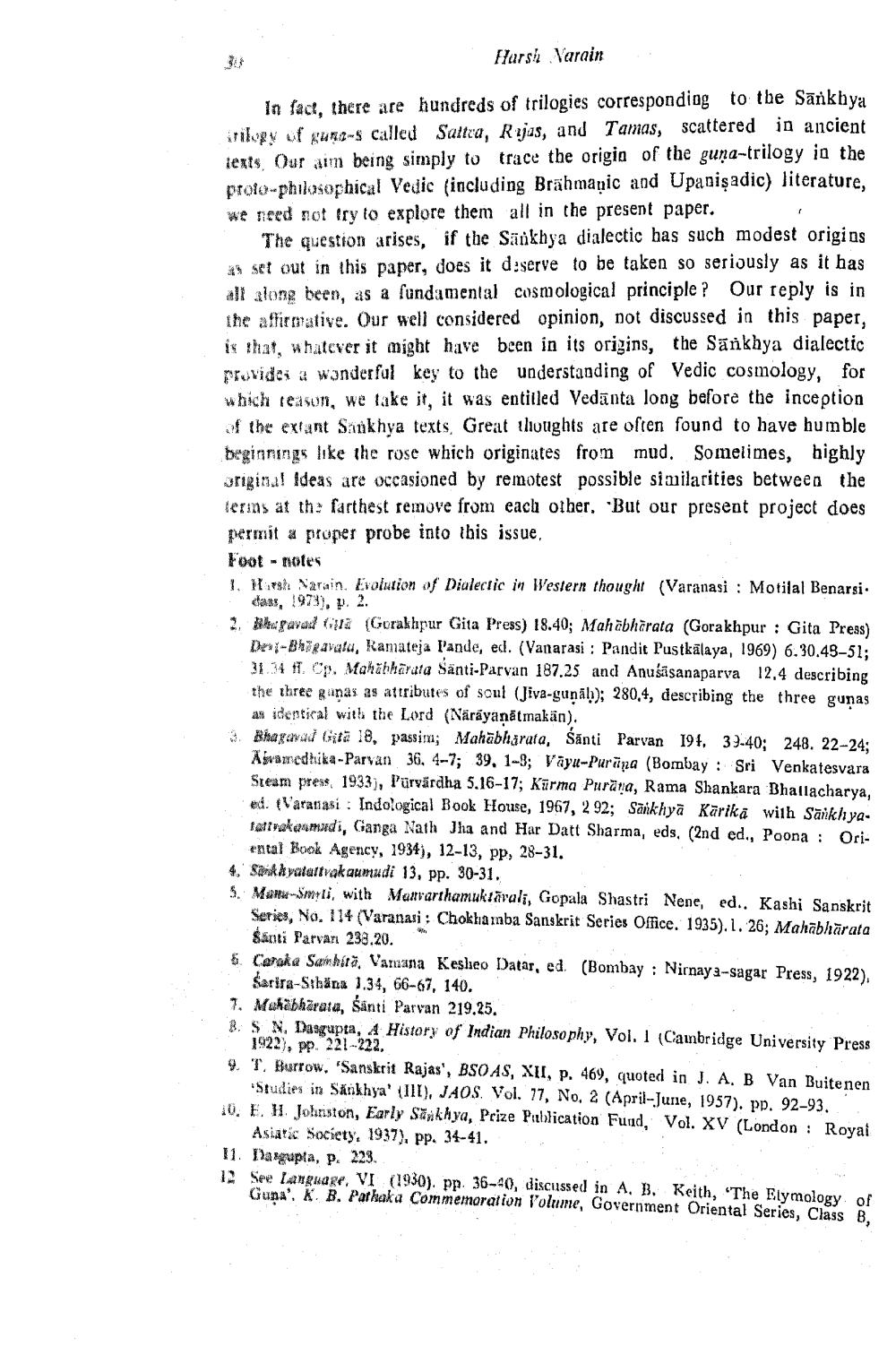________________
Harsh Varain
In fact, there are hundreds of trilogies corresponding to the Sānkhya ilogy of gune-s called Saltca, Rajas, and Tamas, scattered in ancient ients. Our aim being simply to trace the origin of the guna-trilogy in the profe-philosophical Vedic (including Brāhmaṇic and Upaniş adic) literature, we need not try to explore them all in the present paper.
The question arises, if the Sankhya dialectic has such modest origins * set out in this paper, does it deserve to be taken so seriously as it has all along been, as a fundamental cosmological principle ? Our reply is in the affirmative. Our well considered opinion, not discussed in this paper, is that, whatever it might have been in its origins, the Sankhya dialectic Provides a wonderful key to the understanding of Vedic cosmology, for which reason, we take it, it was entitled Vedānta long before the inception of the extant Sankhya texts. Great illoughts are often found to have humble beginnings like the rose which originates from mud. Sometimes, highly original ideas are occasioned by remotest possible similarities between the terins at the farthest remove from each other, But our present project does permit a proper probe into this issue, Foot - notes
1. Harsh Narain. Evolution of Dialectic in Western thought (Varanasi: Motilal Benarsi.
2. Bagavad Ga (Gorakhpur Gita Press) 18.40; Mahabharata (Gorakhpur : Gita Press)
Dest-Bh7gavata, Ramateja l'ande, ed. (Vanarasi : Pandit Pustkalaya, 1969) 6.30.49-51; 31.34 41. C. Mahabharata Sänti-Parvan 187.25 and Anusasanaparva 12.4 describing the three ganas as attributes of soul (Jiva-gunah); 280,4, describing the three gunas
an identical with the Lord (Näráyanātmakän). 3. Bhagavad Gita 18, passim; Mahabharata, Santi Parvan 194, 37-40; 248. 22-24;
Asvamedhika-Parvan 36. 4-7; 39, 1-9; Vāyu-Purūņa (Bombay : Sri Venkatesvara Steam press 1933), Purvärdha 5.16-17; Kūrma Purana, Rama Shankara Bhallacharya, ed. Varanasi : Indological Book House, 1967, 292; Sankhyā Kārika with Sankhya. fattvakaumudi, Ganga Nath Jha and Har Datt Sharma, eds. (2nd ed., Poona : Ori
ental Book Agency, 1934), 12-13, pp, 28-31. 4. Samkåyatartvakaumudi 13, pp. 30-31. 5. Mahmuti, with Matvarthamuktāvali, Gopala Shastri Nene, ed.. Kashi Sanskrit
Series, No. 114 (Varanasi: Chokhamba Sanskrit Series Office. 1935). 1. 26; Mahābhārata
Santi Parvan 238.20. 6. Caraka Samhita. Vamana Kesleo Datar, ed. (Bombay : Nirnaya-sagar Press, 1922).
Sarira-Sthåna 1.34, 66-67, 140. 7. Muhabharata, Santi Parvan 219.25. B. S N Dasgupta, A History of Indian Philosophy, Vol. 1 (Cambridge University Press
1922), pp. 221-222 9. T. Burrow. "Sanskrit Rajas', BSO AS, XII, p. 469, quoted in J. A. B Van Buitenen
Studies in Sankhya' (all), JAOS. Vol. 77, No. 2 (April-June, 1957). pp. 92-93. 10. E. H. Johriston, Early Sankhya, Prize Publication Fund, Vol. XV (London: Royai
Asiatic Society, 1937). pp. 34-41. 11. Nangapta, p. 223 12 See Language, VI (1930). pp. 36-40, discussed in A. B. Keith, "The Elymology of
Guna'. X. B. Parhaka Commemoration l'olume, Government Oriental Series, Class B.




